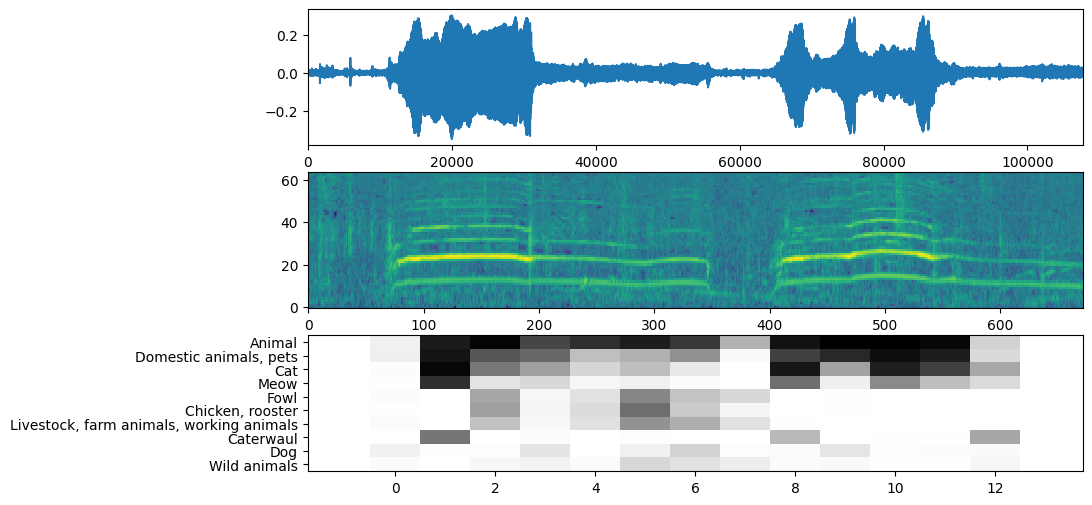 Xem trên TensorFlow.org Xem trên TensorFlow.org |  Chạy trong Google Colab Chạy trong Google Colab |  Xem trên GitHub Xem trên GitHub |  Tải xuống sổ ghi chép Tải xuống sổ ghi chép |  Xem mô hình TF Hub Xem mô hình TF Hub |
YAMNet là một mạng lưới sâu mà dự đoán 521 sự kiện âm thanh lớp học từ corpus AudioSet-YouTube nó được thí nghiệm trên. Nó sử dụng các Mobilenet_v1 kiến trúc chập depthwise-tách.
import tensorflow as tf
import tensorflow_hub as hub
import numpy as np
import csv
import matplotlib.pyplot as plt
from IPython.display import Audio
from scipy.io import wavfile
Tải Mô hình từ TensorFlow Hub.
# Load the model.
model = hub.load('https://tfhub.dev/google/yamnet/1')
Các tập tin nhãn sẽ được nạp từ các mô hình tài sản và có mặt tại model.class_map_path() . Bạn sẽ được tải nó trên class_names biến.
# Find the name of the class with the top score when mean-aggregated across frames.
def class_names_from_csv(class_map_csv_text):
"""Returns list of class names corresponding to score vector."""
class_names = []
with tf.io.gfile.GFile(class_map_csv_text) as csvfile:
reader = csv.DictReader(csvfile)
for row in reader:
class_names.append(row['display_name'])
return class_names
class_map_path = model.class_map_path().numpy()
class_names = class_names_from_csv(class_map_path)
Thêm một phương pháp để xác minh và chuyển đổi âm thanh đã tải về sample_rate (16K) thích hợp, nếu không nó sẽ ảnh hưởng đến kết quả của mô hình.
def ensure_sample_rate(original_sample_rate, waveform,
desired_sample_rate=16000):
"""Resample waveform if required."""
if original_sample_rate != desired_sample_rate:
desired_length = int(round(float(len(waveform)) /
original_sample_rate * desired_sample_rate))
waveform = scipy.signal.resample(waveform, desired_length)
return desired_sample_rate, waveform
Tải xuống và chuẩn bị tệp âm thanh
Tại đây, bạn sẽ tải xuống một tệp wav và nghe nó. Nếu bạn đã có sẵn một tập tin, chỉ cần tải nó lên colab và sử dụng nó thay thế.
curl -O https://storage.googleapis.com/audioset/speech_whistling2.wav
% Total % Received % Xferd Average Speed Time Time Time Current
Dload Upload Total Spent Left Speed
100 153k 100 153k 0 0 267k 0 --:--:-- --:--:-- --:--:-- 266k
curl -O https://storage.googleapis.com/audioset/miaow_16k.wav
% Total % Received % Xferd Average Speed Time Time Time Current
Dload Upload Total Spent Left Speed
100 210k 100 210k 0 0 185k 0 0:00:01 0:00:01 --:--:-- 185k
# wav_file_name = 'speech_whistling2.wav'
wav_file_name = 'miaow_16k.wav'
sample_rate, wav_data = wavfile.read(wav_file_name, 'rb')
sample_rate, wav_data = ensure_sample_rate(sample_rate, wav_data)
# Show some basic information about the audio.
duration = len(wav_data)/sample_rate
print(f'Sample rate: {sample_rate} Hz')
print(f'Total duration: {duration:.2f}s')
print(f'Size of the input: {len(wav_data)}')
# Listening to the wav file.
Audio(wav_data, rate=sample_rate)
Sample rate: 16000 Hz Total duration: 6.73s Size of the input: 107698 /tmpfs/src/tf_docs_env/lib/python3.7/site-packages/ipykernel_launcher.py:3: WavFileWarning: Chunk (non-data) not understood, skipping it. This is separate from the ipykernel package so we can avoid doing imports until
Các wav_data cần phải được bình thường đến các giá trị trong [-1.0, 1.0] (như đã nêu trong của mô hình tài liệu ).
waveform = wav_data / tf.int16.max
Thực thi mô hình
Bây giờ là phần dễ dàng: sử dụng dữ liệu đã được chuẩn bị sẵn, bạn chỉ cần gọi mô hình và nhận: điểm số, nhúng và biểu đồ quang phổ.
Điểm số là kết quả chính mà bạn sẽ sử dụng. Biểu đồ quang phổ bạn sẽ sử dụng để thực hiện một số hình dung sau này.
# Run the model, check the output.
scores, embeddings, spectrogram = model(waveform)
scores_np = scores.numpy()
spectrogram_np = spectrogram.numpy()
infered_class = class_names[scores_np.mean(axis=0).argmax()]
print(f'The main sound is: {infered_class}')
The main sound is: Animal
Hình dung
YAMNet cũng trả về một số thông tin bổ sung mà chúng tôi có thể sử dụng để hình dung. Chúng ta hãy xem xét Dạng sóng, biểu đồ quang phổ và các lớp hàng đầu được suy ra.
plt.figure(figsize=(10, 6))
# Plot the waveform.
plt.subplot(3, 1, 1)
plt.plot(waveform)
plt.xlim([0, len(waveform)])
# Plot the log-mel spectrogram (returned by the model).
plt.subplot(3, 1, 2)
plt.imshow(spectrogram_np.T, aspect='auto', interpolation='nearest', origin='lower')
# Plot and label the model output scores for the top-scoring classes.
mean_scores = np.mean(scores, axis=0)
top_n = 10
top_class_indices = np.argsort(mean_scores)[::-1][:top_n]
plt.subplot(3, 1, 3)
plt.imshow(scores_np[:, top_class_indices].T, aspect='auto', interpolation='nearest', cmap='gray_r')
# patch_padding = (PATCH_WINDOW_SECONDS / 2) / PATCH_HOP_SECONDS
# values from the model documentation
patch_padding = (0.025 / 2) / 0.01
plt.xlim([-patch_padding-0.5, scores.shape[0] + patch_padding-0.5])
# Label the top_N classes.
yticks = range(0, top_n, 1)
plt.yticks(yticks, [class_names[top_class_indices[x]] for x in yticks])
_ = plt.ylim(-0.5 + np.array([top_n, 0]))


